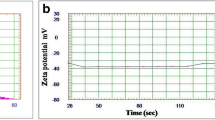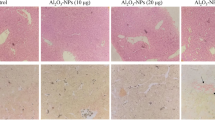Abstract
As a new type of biologically compatible material, TiO2 NPs are widely used in the industry as additives, drug carriers, and components of skin care products. Due to their wide use, residual TiO2 NPs in the environment are a safety concern that has attracted extensive attention. In this study, the ovarian cell line BmN of the model organism Bombyx mori was used to reveal the damaging effects of TiO2 NPs exposure. The results demonstrated that TiO2 NPs exhibited a dose-dependent effect on the relative cell viability, with significant toxic effects being observed above 20 mg/L. Oxidative damage analysis showed that ROS accumulated significantly in BmN cells after exposure to TiO2 NPs (P ≤ 0.05) and induced DNA damage. Further analysis revealed that the transcriptional levels of key superoxide dismutase genes (SOD) decreased significantly, while the transcriptions of key genes of the MAPK/NF-κB signaling pathway (P38, MEK, ERK and REL) and the downstream inflammatory factor genes (IL6 and TNFSF5) were all significantly up-regulated (P ≤ 0.05). Overall, our results indicate that exposure to TiO2 NPs leads to reduced transcription of antioxidant genes, accumulation of peroxides, and inflammation. These findings provide valuable data for the safety evaluation of environmental residues of TiO2 NPs.




Similar content being viewed by others
Data Availability
The datasets generated during and/or analyzed during the current study are available from the corresponding author on reasonable request.
Code Availability
(Not applicable).
References
Peters RJB, Bemmel GV, Herrera-Rivera Z, Helsper JPFG, Bouwmeester H (2014) Characterization of titanium dioxide nanoparticles in food products: analytical methods to define nanoparticles. J Agric Food Chem 62(27):6285–6293
Jia H, Kerr LL (2015) Kinetics of drug release from drug carrier of polymer/ TiO2 nanotubes composite-pH dependent study. J Appl Polym Sci 132(7)
Tyner KM, Wokovich AM, Godar DE, Doub WH, Sadrieh N (2011) The state of nano-sized titanium dioxide (TiO2) may affect sunscreen performance. Int J Cosmet Sci 33(3):234–244
Jaroenworaluck A, Sunsaneeyametha W, Kosachan N, Stevens R (2010) Characteristics of silica-coated TiO2 and its UV absorption for sunscreen cosmetic applications. Surf Interface Anal 38(4):473–477
Gangwal S, Brown JS, Wang A, Houck KA, Dix DJ, Kavlock RJ, Hubal EA (2011) Informing selection of nanomaterial concentrations for ToxCast in vitro testing based on occupational exposure potential. Environ Health Perspect 119:1539–1546
Zhao Y, Tang YZ, Chen L, Lv SD, Liu SJ, Nie PH, Aguilar ZP, Xu HY (2020) Restraining the TiO2 nanoparticles-induced intestinal inflammation mediated by gut microbiota in juvenile rats via ingestion of Lactobacillus rhamnosus GG. Ecotoxicol Environ Saf 206:111393
Weir A, Westerhoff P, Fabricius L, Hristovski K, Goetz NV (2012) Titanium dioxide nanoparticles in food and personal care products. Environ Sci Technol 46:2242–2250
Wang JX, Zhu XS, Zhang XZ, Zhao Z, Liu H, George R, Wilson-Rawls J, Chang Y, Chen YS (2011) Disruption of zebrafish (Danio rerio) reproduction upon chronic exposure to TiO2 nanoparticles. Chemosphere 83(4):461–467
Philbrook NA, Winn LM, Afrooz ARMN, Saleh NB, Walker VK (2011) The effect of TiO2 and Ag nanoparticles on reproduction and development of Drosophila melanogaster and CD-1 mice. Toxicol Appl Pharmacol 257(3):429–436
Zhang JY, Pan MH, Sun ZY (2010) The genomic underpinnings of apoptosis in the silkworm Bombyx mori. BMC Genomics 11:611–619
Wen CW, Shi L, Zhao YQ, Ouyang Z, Zhan ZL (2017) Herbal textual research on origin and development of Bombyx batryticatus. Lishizhen Med Mater Med Res 28(1):171–173
Jiang L, Peng LL, Cao YY, Thakur K, Hu F, Tang SM, Wei ZJ (2020) Effect of Dietary Selenium Supplementation on Growth and Reproduction of Silkworm Bombyx mori L.. Biol Trace Elem Res 193:271–281
Jiang L, Peng LL, Cao YY, Thakur K, Hu F, Tang SM, Wei ZJ (2020) Transcriptome analysis reveals gene expression changes of the fat body of silkworm (Bombyx mori L.) in response to selenium treatment. Chemosphere 245:125660
Zhang H, Ni M, Li FC, Xu KZ, Wang BB, Hong FS, Shen WD, Li B (2014) Effects of feeding silkworm with nanoparticulate anatase TiO2 (TiO2 NPs) on its feed efficiency. Biol Trace Elem Res 159:224–232
Li JX, Xue B, Chen XY (2018) TiO2 NPs Alleviates High-Temperature Induced Oxidative Stress in Silkworms. J Econ Entomol 111(2):879–884
Ma LL, Liu J, Li N, Wang J, Duan YM, Yan JY, Liu HT, Wang H, Hong FS (2010) Oxidative stress in the brain of mice caused by translocated nanoparticulate TiO2 delivered to the abdominal cavity. Biomaterials 31(1):99–105
Matsuda-Imai N, Katsuma S (2020) Characterization of Bombyx mori nucleopolyhedrovirus infection in fat body-derived Bombyx mori cultured cells. J Invertebr Pathol 177:107476
Kumaravel TS, Brabu B, Parthiban N, Murugan SS, Jha AN (2021) Site of contact genotoxicity’ assessment for implants-Potential use of single cell gel electrophoresis in biocompatibility testing of medical devices. Toxicol Lett 341:59–67
Li H, Wang M, Kang W, Lin Z, Gan F, Huang K (2021) Non-cytotoxic dosage of fumonisin B1 aggravates ochratoxin A-induced nephrocytotoxicity and apoptosis via ROS-dependent JNK/MAPK signaling pathway. Toxicology 457:152802
Rosati R, Romeo L, Silvestri S, Marcheggiani F, Tiano L, Frontoni E (2020) Faster R-CNN approach for detection and quantification of DNA damage in comet assay images. Comput Biol Med 123:103912
Donos N, Retzepi M, Wall I, Hamlet S, Ivanovski S (2011) In vivo gene expression profile of guided bone regeneration associated with a microrough titanium surface. Clin Oral Implants Res 22:390–398
Retzepi M, Lewis MP, Donos N (2010) Effect of diabetes and metabolic control on de novo bone formation following guided bone regeneration. Clin Oral Implants Res 21:71–79
Xie Y, Wang BB, Li FC, Ma L, Ni M, Shen WD, Hong FS, Li B (2014) Molecular Mechanisms of Reduced Nerve Toxicity by Titanium Dioxide Nanoparticles in the Phoxim-Exposed Brain of Bombyx mori. PLoS ONE 9(6):e101062
Li B, Hu RP, Cheng Z, Cheng J, Xie Y, Gui SX, Sun QQ, Sang XZ, Gong XL, Cui YL, Shen WD, Hong FS (2012) Titanium dioxide nanoparticles relieve biochemical dysfunctions of fifth-instar larvae of silkworms following exposure to phoxim insecticide. Chemosphere 89:609–614
Su JJ, Li B, Cheng S, Zhu Z, Sang XZ (2014) Phoxim-induced damages of Bombyx mori larval midgut and titanium dioxide nanoparticles protective role under phoxim-induced toxicity. Environ Toxicol 29(12):1355–1366
Mei XG, Yang ZB, Li MY, Xie XY, Gao GY (2014) Physical damage-the origin of nanotoxicity. Chin J Pharmacol Toxicol 28:154–160
Dimitrijevic NM, Rozhkova E, Rajh T (2009) Dynamics of localized charges in dopamine-modified TiO2 and their effect on the formation of reactive oxygen species. J Am Chem Soc 131(8):2893–2899
Kermanizadeh A, Gaiser BK, Hutchison GR, Stone V (2012) An in vitro liver model-assessing oxidative stress and genotoxicity following exposure of hepatocytes to a panel of engineered nanomaterials. Part Fibre Toxicol 9:28
Liang G, Pu Y, Yin L, Liu R, Ye B, Su Y, Li Y (2009) Influence of Different Sizes of Titanium Dioxide Nanoparticles on Hepatic and Renal Functions in Rats with Correlation to Oxidative Stress. J Toxicol Environ Health, Part A 72(11–12):740–745
Shukla RK, Kumar A, Gurbani D, Pandey AK, Singh S, Dhawan A (2013) TiO2 nanoparticles induce oxidative DNA damage and apoptosis in human liver cells. Nanotoxicology 7(1):48–60
Giulio RTD, Washburn PC, Wenning RJ, Winstion GW, Jewell CS (1989) Biochemical responses in aquatic animals: A review of determinants of oxidative stress. Environ Toxicol Chem 8:1103–1123
Yu BP (1994) Cellular defenses against damage from reactive oxygen species. Physiol Rev 74:139–162
Park SY, Nair PM, Choi J (2012) Characterization and expression of superoxide dismutase genes in Chironomus riparius (Diptera, Chironomidae) larvae as a potential biomarker of ecotoxicity. Comp Biochem Physiol Part C Toxicol Pharmacol 156:187–194
Lim YS, Cha MK, Kim HK, Uhm TB, Park JW, Kim K, Kim IH (1993) Removals of hydrogen peroxide and hydroxyl radical by thiol-specific antioxidant protein as a possible role in vivo. Biochem Biophys Res Commun 192:273–280
Lee I-T, Yang C-M (2012) Role of NADPH oxidase/ ROS in pro-inflammatory mediators-induced airway and pulmonary diseases. Biochem Pharmacol 84(5):581–590
Steward R (1987) Dorsal, an embryonic polarity gene in Drosophila, is homologous to the vertebrate proto-oncogene, c-rel. Science 238:692–694
Ip YT, Reach M, Engström Y, Kadalayil L, Cai H, Gonzales-Crespo S, Tatei K, Levine M (1993) Dif, a dorsal-related gene that mediates an immune response in Drosophila. Cell 75:753–763
Baeza-Raja B, Muñoz-Cánoves P (2004) P38 MAPK-induced Nuclear Factor-κB Activity Is Required for Skeletal Muscle Differentiation: Role of Interleukin-6. Mol Biol Cell 15(4):2013–2026
Tilstra JS, Clauson CL, Niedernhofer LJ, Robbins PD (2011) NF-kappaB in aging and disease. Aging Dis 2:449–465
Mendonca P, Taka E, Bauer D, Reams RR, Soliman KFA (2018) The attenuating effects of 1,2,3,4,6 penta-O-galloyl-beta-d-glucose on pro-inflammatory responses of LPS/IFNγ-activated BV-2 microglial cells through NFkB and MAPK signaling pathways. J Neuroimmunol 324:43–53
Acknowledgements
This study was supported by the China Agriculture Research System (CARS-18-ZJ0106), the grants from National Natural Science Foundation of China (Grant 31870148), the China Postdoctoral Science Foundation funded project (2019M651951), the Science & Technology Support Program of Suzhou (SNG201925, SNG201912), the QingLan Project of Jiangsu Province, and a project funded by the Priority Academic Program Development of Jiangsu Higher Education Institutions.
Author information
Authors and Affiliations
Contributions
Yilong Fang: Conceptualization, Methodology, Experimental, Writing—original draft.
Mingli Dai: Determination of ROS level, Data analysis.
Wentao Ye: Total RNA extraction, Data analysis.
Fanchi Li: Experimental guidance, Resources, Writing—review & editing.
Haina Sun: Experimental guidance, Resources, Writing—review & editing.
Jing Wei: Project design and administration, Writing—review & editing.
Bing Li: Project design and administration, Writing—review & editing.
Corresponding author
Ethics declarations
Ethics Approval
(Not applicable).
Consent to Participate
(Not applicable).
Consent for Publication
(Not applicable).
Conflicts of Interest
The authors declare that they have no known competing financial interests or personal relationships that could have appeared to influence the work reported in this paper.
Additional information
Publisher's Note
Springer Nature remains neutral with regard to jurisdictional claims in published maps and institutional affiliations.
Rights and permissions
About this article
Cite this article
Fang, Y., Dai, M., Ye, W. et al. Damaging effects of TiO2 nanoparticles on the ovarian cells of Bombyx mori. Biol Trace Elem Res 200, 1883–1891 (2022). https://doi.org/10.1007/s12011-021-02760-9
Received:
Accepted:
Published:
Issue Date:
DOI: https://doi.org/10.1007/s12011-021-02760-9




